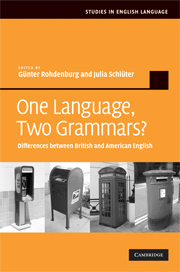Book contents
- Frontmatter
- Contents
- List of figures
- List of tables
- List of contributors
- Introduction
- 1 Colonial lag, colonial innovation or simply language change?
- 2 Compound verbs
- 3 The formation of the preterite and the past participle
- 4 Synthetic and analytic comparatives
- 5 Phonology and grammar
- 6 Prepositions and postpositions
- 7 Argument structure
- 8 Reflexive structures
- 9 Noun phrase modification
- 10 Nominal complements
- 11 Non-finite complements
- 12 The present perfect and the preterite
- 13 The revived subjunctive
- 14 The mandative subjunctive
- 15 The conditional subjunctive
- 16 Tag questions
- 17 The pragmatics of adverbs
- 18 How different are American and British English grammar? And how are they different?
- 19 New departures
- Bibliography
- Index
8 - Reflexive structures
Published online by Cambridge University Press: 03 July 2009
- Frontmatter
- Contents
- List of figures
- List of tables
- List of contributors
- Introduction
- 1 Colonial lag, colonial innovation or simply language change?
- 2 Compound verbs
- 3 The formation of the preterite and the past participle
- 4 Synthetic and analytic comparatives
- 5 Phonology and grammar
- 6 Prepositions and postpositions
- 7 Argument structure
- 8 Reflexive structures
- 9 Noun phrase modification
- 10 Nominal complements
- 11 Non-finite complements
- 12 The present perfect and the preterite
- 13 The revived subjunctive
- 14 The mandative subjunctive
- 15 The conditional subjunctive
- 16 Tag questions
- 17 The pragmatics of adverbs
- 18 How different are American and British English grammar? And how are they different?
- 19 New departures
- Bibliography
- Index
Summary
Introduction
While the earlier history of reflexive marking has been researched in depth up to and including Early Modern English (see, in particular, Peitsara 1997), comparatively little is known about the last three centuries. Even so, the evidence supplied by Jespersen (1927: 325–31), Visser (1963: 420–39), Peitsara (1997: 348–9) and others allows us to assume the following scenario:
Having completely ousted its simpler rival, the use of personal pronouns (e.g. I washed me), by the end of the Early Modern English period, the prevailing construction using the reflexive pronoun (e.g. I washed myself) has been steadily contracting its range of application both in terms of verb types and its frequency of use.
There are a number of rivalling structures that are held responsible for the general decrease of overtly reflexive uses in Modern English. The most direct and best researched (though not necessarily the most important) competitor is provided by the so-called zero variant (e.g. I washed), which has established itself at the expense of the reflexive pronoun with a subset of ‘essentially reflexive’ (or self-directed/introverted) verbs. This certainly is in line with the typological evidence as presented by, e.g., Haiman (1983), Faltz (1985), König and Siemund (2000), König (2003) and Smith (2004).
In this chapter, we will demonstrate that the reduction of overtly reflexive uses is continuing unabated and that it is AmE that has been implementing these changes faster and more extensively than BrE.
- Type
- Chapter
- Information
- One Language, Two Grammars?Differences between British and American English, pp. 166 - 181Publisher: Cambridge University PressPrint publication year: 2009
- 8
- Cited by



